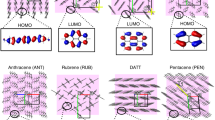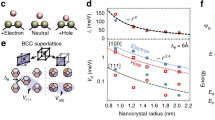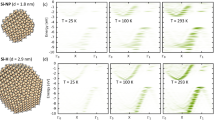Abstract
The response of charge to externally applied electric fields is an important basic property of any material system, as well as one critical for many applications. Here, we examine the behaviour and dynamics of charges fully confined on the nanometre length scale. This is accomplished using CdSe nanocrystals1,2,3 of controlled radius (1–2.5 nm) as prototype quantum systems. Individual electron–hole pairs are created at room temperature within these structures by photoexcitation and are probed by terahertz (THz) electromagnetic pulses4. The electronic response is found to be instantaneous even for THz frequencies, in contrast to the behaviour reported in related measurements for larger nanocrystals5 and nanocrystal assemblies6,7. The measured polarizability of an electron–hole pair (exciton) amounts to ∼104 Å3 and scales approximately as the fourth power of the nanocrystal radius. This size dependence and the instantaneous response reflect the presence of well-separated electronic energy levels induced in the system by strong quantum-confinement effects.
This is a preview of subscription content, access via your institution
Access options
Subscribe to this journal
Receive 12 print issues and online access
$259.00 per year
only $21.58 per issue
Buy this article
- Purchase on Springer Link
- Instant access to full article PDF
Prices may be subject to local taxes which are calculated during checkout



Similar content being viewed by others
References
Woggon, U. Optical Properties of Semiconductor Quantum Dots (Springer, Berlin, 1997).
Murray, C. B., Norris, D. J. & Bawendi, M. G. Synthesis and characterization of nearly monodisperse CdE (E=S, Se, Te) semiconductor nanocrystallites. J. Am. Chem. Soc. 115, 8706–8715 (1993).
Norris, D. J. & Bawendi, M. G. Measurement and assignment of the size-dependent optical spectrum in CdSe quantum dots. Phys. Rev. B 53, 16338–16346 (1996).
Schmuttenmaer, C. A. Exploring dynamics in the far-infrared with terahertz spectroscopy. Chem. Rev. 104, 1759–1779 (2004).
Beard, M. C., Turner, G. M. & Schmuttenmaer, C. A. Size-dependent photoconductivity in CdSe nanoparticles as measured by time-resolved terahertz spectroscopy. Nano Lett. 2, 983–987 (2002).
Beard, M. C. et al. Electronic coupling in InP nanoparticle arrays. Nano Lett. 3, 1695–1699 (2003).
Cooke, D. G. et al. Anisotropic photoconductivity of InGaAs quantum dot chains measured by terahertz pulse spectroscopy. Appl. Phys. Lett. 85, 3839–3841 (2004).
Hines, M. A. & Guyot-Sionnest, P. Synthesis and characterization of strongly luminescing ZnS-capped CdSe nanocrystals. J. Phys. Chem. 100, 468–471 (1996).
Efros, A. L. & Rosen, M. The electronic structure of semiconductor nanocrystals. Annu. Rev. Mater. Sci. 30, 475–521 (2000).
Klimov, V. I. et al. Optical gain and stimulated emission in nanocrystal quantum dots. Science 290, 314–317 (2000).
Colvin, V. L., Schlamp, M. C. & Alivisatos, A. P. Light-emitting-diodes made from cadmium selenide nanocrystals and a semiconducting polymer. Nature 370, 354–357 (1994).
Ginger, D. S. & Greenham, N. C. Charge injection and transport in films of CdSe nanocrystals. J. Appl. Phys. 87, 1361–1368 (2000).
Empedocles, S. A. & Bawendi, M. G. Quantum-confined Stark effect in single CdSe nanocrystallite quantum dots. Science 278, 2114–2117 (1997).
Sacra, A., Norris, D. J., Murray, C. B. & Bawendi, M. G. Stark spectroscopy of CdSe nanocrystallites—the significance of transition linewidths. J. Chem. Phys. 103, 5236–5245 (1995).
Seufert, J. et al. Stark effect and polarizability in a single CdSe/ZnSe quantum dot. Appl. Phys. Lett. 79, 1033–1035 (2001).
Klimov, V. I. Optical nonlinearities and ultrafast carrier dynamics in semiconductor nanocrystals. J. Phys. Chem. B 104, 6112–6123 (2000).
Beard, M. C., Turner, G. M. & Schmuttenmaer, C. A. Terahertz spectroscopy. J. Phys. Chem. B 106, 7146–7159 (2002).
Groeneveld, R. H. M. & Grischkowsky, D. Picosecond time-resolved far-infrared experiments on carriers and excitons in GaAs-AlGaAs multiple-quantum wells. J. Opt. Soc. Am. B 11, 2502–2507 (1994).
Hegmann, F. A., Tykwinski, R. R., Lui, K. P. H., Bullock, J. E. & Anthony, J. E. Picosecond transient photoconductivity in functionalized pentacene molecular crystals probed by terahertz pulse spectroscopy. Phys. Rev. Lett. 89, 227403 (2002).
Thorsmolle, V. K. et al. Ultrafast conductivity dynamics in pentacene probed using terahertz spectroscopy. Appl. Phys. Lett. 84, 891–893 (2004).
Huber, R. et al. How many-particle interactions develop after ultrafast excitation of an electron–hole plasma. Nature 414, 286–289 (2001).
Shan, J., Wang, F., Knoesel, E., Bonn, M. & Heinz, T. F. Measurement of the frequency-dependent conductivity in sapphire. Phys. Rev. Lett. 90, 247401 (2003).
Averitt, R. D. et al. Ultrafast conductivity dynamics in colossal magnetoresistance manganites. Phys. Rev. Lett. 87, 17401 (2001).
Beard, M. C., Turner, G. M. & Schmuttenmaer, C. A. Transient photoconductivity in GaAs as measured by time-resolved terahertz spectroscopy. Phys. Rev. B 62, 15764–15777 (2000).
Turchinovich, D. et al. Ultrafast polarization dynamics in biased quantum wells under strong femtosecond optical excitation. Phys. Rev. B 68, 241307 (2003).
Muller, T., Parz, W., Strasser, G. & Unterrainer, K. Pulse-induced quantum interference of intersubband transitions in coupled quantum wells. Appl. Phys. Lett. 84, 64–66 (2004).
Kaindl, R. A., Carnahan, M. A., Hagele, D., Lovenich, R. & Chemla, D. S. Ultrafast terahertz probes of transient conducting and insulating phases in an electron–hole gas. Nature 423, 734–738 (2003).
Hendry, E. et al. Direct observation of electron-to-hole energy transfer in CdSe quantum dots. Phys. Rev. Lett. 96, 057408 (2006).
Knoesel, E., Bonn, M., Shan, J. & Heinz, T. F. Charge transport and carrier dynamics in liquids probed by THz time-domain spectroscopy. Phys. Rev. Lett. 86, 340–343 (2001).
Underwood, D. F., Kippeny, T. & Rosenthal, S. J. Ultrafast carrier dynamics in CdSe nanocrystals determined by femtosecond fluorescence upconversion spectroscopy. J. Phys. Chem. B 105, 436–443 (2001).
Guyot-Sionnest, P., Shim, M., Matranga, C. & Hines, M. Intraband relaxation in CdSe quantum dots. Phys. Rev. B 60, R2181–R2184 (1999).
Lide, D. R. Handbook of Chemistry and Physics (CRC Press, New York, 1999).
Choy, T. C. Effective Medium Theory—Principles and Applications (Oxford Science Publications, Oxford, 1999).
Gelinck, G. H. et al. Measuring the size of excitons on isolated phenylene-vinylene chains: From dimers to polymers. Phys. Rev. B 62, 1489–1491 (2000).
Nahata, A., Weling, A. S. & Heinz, T. F. A wideband coherent terahertz spectroscopy system using optical rectification and electro-optic sampling. Appl. Phys. Lett. 69, 2321–2323 (1996).
Acknowledgements
Research at Columbia University was supported primarily by the MRSEC Program of the National Science Foundation under award number DMR-0213574 and by the New York State Office of Science, Technology and Academic Research (NYSTAR), with additional support from US Department of Energy, Office of Basic Energy Sciences, through the Catalysis Science Program. Work at Case Western Reserve University was supported by NSF grant DMR-0349201.
Author information
Authors and Affiliations
Corresponding author
Ethics declarations
Competing interests
The authors declare no competing financial interests.
Supplementary information
Supplementary Information
Supplementary information (PDF 54 kb)
Rights and permissions
About this article
Cite this article
Wang, F., Shan, J., Islam, M. et al. Exciton polarizability in semiconductor nanocrystals. Nature Mater 5, 861–864 (2006). https://doi.org/10.1038/nmat1739
Received:
Accepted:
Published:
Issue Date:
DOI: https://doi.org/10.1038/nmat1739
This article is cited by
-
High-performance terahertz modulators induced by substrate field in Te-based all-2D heterojunctions
Light: Science & Applications (2024)
-
Ultrafast light-based logic with graphene
Nature Materials (2023)
-
Real-time power flow analysis and management for a long-endurance solar UAV during continuous flight
CEAS Aeronautical Journal (2023)
-
Size-controlled quantum dots reveal the impact of intraband transitions on high-order harmonic generation in solids
Nature Physics (2022)
-
Subcycle contact-free nanoscopy of ultrafast interlayer transport in atomically thin heterostructures
Nature Photonics (2021)



